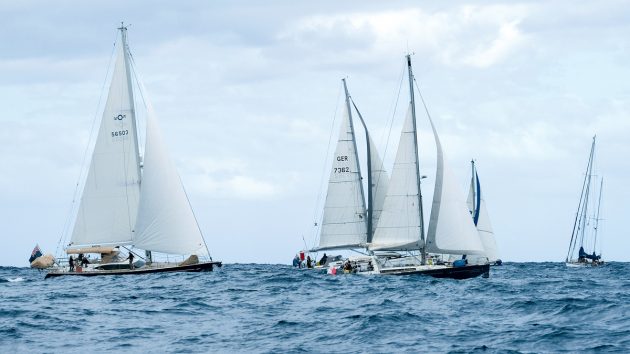Every year more than 200 boats set sail from Gran Canaria to the Caribbean on the Atlantic Rally for Cruisers (ARC), bristling with a whole host of offshore sailing gear…
The organisers, World Cruising Club (WCC), have strict safety requirements for participants and check all boats’ offshore sailing gear before departure from Las Palmas.
They expect all boats to carry a minimum quantity and quality of safety and communications equipment, and to have undertaken training in its usage, heavy weather sailing techniques, and managing emergencies.
The offshore sailing gear requirements are based on the ISAF standards, and include:
- An offshore liferaft with a more than 24 hour pack
- A 406MHz EPIRB
- A means of sending and receiving email at sea (satellite phone or SSB radio/pactor modem)
- AIS receiver and man-overboard equipment.
- Every crewmember must have an inflatable combined lifejacket-harness (PFD) with a spray hood, crotch strap and safety line.
Article continues below…
Offshore sailing gear: How to prepare a boat for extended cruising
Sea Bear is a Vancouver 28 built in 1987. She was generally in very good condition when I bought her,…
How long can you survive in a liferaft?
As the deadline for the Cheeki Rafiki search looms, we look at cases of survival in liferafts
Flares
Regarding flares, the World Cruising Club requires all yachts to carry pyrotechnic flares and a minimum of:
- Four red handheld flares (two of which may be electronic flares – these are LED, not laser)
- Two buoyant orange float smokes (required for World Sailing Offshore Special Regulations Cat 1).
Flares must be pyrotechnic SOLAS compliant, not older than the stamped expiry date, or four years from date of manufacture, for the end date of the rally.
Pyrotechnic flares need to be stowed in a watertight container, with protective gloves and goggles. It’s important that the crew know how to use these, and that the container is kept somewhere readily accessible in an emergency.
Boat owners share their offshore sailing gear essentials
Nick Deacon and Michelle Cruwys sailed the 2021 ARC with their grown-up children on Maalu 4, a Nyad 511
“We’ve got pyrotechnic flares and LED boat flares because the ARC specifies we have both,” explains Michelle Cruwys. “Personally I think LED flares are way better; they’re super-bright.
“They’re only handheld, though, not rocket flares, but you still get that brilliant light. I must say, the idea of holding a [pyrotechnic] handheld red flare doesn’t appeal to me, especially not in the liferaft.
“I’m a retired consultant paediatrician and I’m very keen on safety. I’ve got a very well stocked medical kit.
“We’re in our 60s and I want to be able to manage everything I can at sea. Burns are my biggest worry.”
“We did a lot of preparation for the trip,” adds Nick Deacon. “We have a new liferaft, jonbuoy, lifeline, handy billy for lifting people out, rope ladder for the side, as well as the usual set of flares, two EPIRBs, some electronic flares, and lifejackets which have the mini AIS units attached.
“They’re a great idea, because if someone falls overboard the chartplotter will take you back to them.
“We did the RYA Safety at Sea one-day course with a liferaft in a swimming pool. That was really good. We learned techniques for getting in and out, and for staying warm.
“We made sure our children went and did that course as well. If it’s pitch dark, at least the course will give you some familiarity with a liferaft.“
You can find more helpful advice about safety kit on the World Cruising Club website.
Why not subscribe today?
This feature appeared in the February 2022 edition of Practical Boat Owner. For more articles like this, including DIY, money-saving advice, great boat projects, expert tips and ways to improve your boat’s performance, take out a magazine subscription to Britain’s best-selling boating magazine.
Subscribe, or make a gift for someone else, and you’ll always save at least 30% compared to newsstand prices.
See the latest PBO subscription deals on magazinesdirect.com








